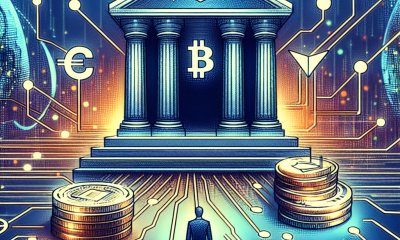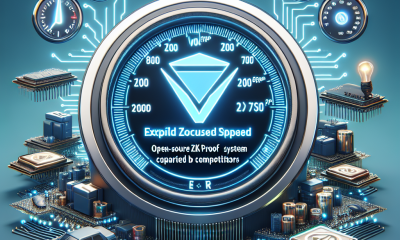Solana
The Saga of the Titanic Timepiece: Navigating the Waters of Legal Disputes

In the aftermath of the FTX collapse, a stark contrast has emerged between the fortunes of its former executives. Patrick Gruhn, renowned for leading FTX Europe, recently captured the spotlight for acquiring a piece of history—the 14-karat gold pocket watch owned by John Jacob Astor IV, a relic from the Titanic disaster, for a reported $1.49 million. The sale, managed by Henry Aldridge & Son, a British auction house celebrated for its Titanic memorabilia, marks a significant entry into Gruhn’s collection. This artifact, intended as a profound gift for his wife and slated for museum exhibition, symbolizes resilience and the indomitable spirit of human history.
Gruhn’s acquisition is a testament to his successful negotiation to disentangle himself from potential legal entanglements following the FTX scandal. Freed from a lawsuit that could have required him to return upwards of $320 million, purportedly overpaid by Sam Bankman-Fried for the acquisition of the Swiss firm that transformed into FTX Europe, Gruhn has managed to distance himself from the controversy. His purchase of the Titanic watch was funded by the proceeds from selling his companies, showcasing his ability to thrive amidst adversity. Further distinguishing his post-FTX trajectory, Gruhn has embarked on launching a new business focusing on creating a crypto derivatives exchange in Europe, alongside running a German Catholic TV network, evidencing his diverse interests and resilience.
On the opposite end of the spectrum, Ryan Salame, the former co-chief executive of FTX Digital Markets, encounters a grim aftermath of the FTX fiasco. Salame agreed to forfeit his $5.8 million property in the Bahamas, a decision stemming from his involvement in legal troubles leading to a guilty plea on fraud and conspiracy charges. His awaited sentencing in late May 2024 follows his release on a bond worth $1.05 million. This contrast paints a vivid picture of the varied fates befalling FTX’s former executives in the wake of the company’s dramatic collapse.
Furthermore, the FTX estate has been actively liquidating its solana token holdings, triggering keen interest among crypto investors and firms like Galaxy Trading and Pantera Capital. The second wave of these token sales, priced between $84 and $109 each, has drawn considerable attention despite offering discounts on the prevailing market rates. This strategy aligns with the estate’s broader objective of initiating investor repayments by the closing stages of 2024, reflecting a meticulously planned approach to mitigate the fallout from one of the most significant scandals in crypto history. These developments underscore the ongoing efforts by FTX’s new management and the appointed liquidators to navigate the complex bankruptcy processes in the US and the Bahamas, aiming for a structured unwinding of the company’s assets to reimburse its creditors.
The saga of FTX’s rise and fall remains a cautionary tale within the fintech and crypto industries, highlighting the imperatives of regulatory oversight, corporate governance, and the inherent volatility of digital assets. As the legal proceedings and asset liquidation processes unfold, the industry observers and participants are reminded of the crucial balance between innovation and risk management in the pursuit of sustainable growth in the highly speculative and turbulent crypto market. The divergent paths of Gruhn and Salame post-FTX serve as emblematic narratives within this broader context, illustrating the multifaceted impacts of the company’s unraveling on its key stakeholders and the ongoing attempts to rectify the implications of its demise.
Memecoins
Judge Challenges Coinbase’s Subpoena Push Against SEC Chair, Citing Irrelevance and Misjudgment

In a recent judiciary proceeding, Judge Katherine Polk Failla expressed criticism towards Coinbase’s attempt to serve a subpoena to Gary Gensler, the Chairman of the Securities and Exchange Commission (SEC). The judge highlighted the seemingly unwarranted nature of the request for documents from Gensler’s tenure and the years preceding it. The call for such extensive disclosure raised eyebrows and was deemed as potentially deviating from the relevant legal standards.
The matter unfolded in the District Court for the Southern District of New York, where Judge Failla openly questioned the strategic approach by Coinbase. The exchange had sought to compel Gensler to produce documents and communications from both his period as SEC Chair and the four preceding years. This demand by Coinbase was part of their broader effort to gather evidence in ongoing litigation against the SEC, which had taken a hardline stance on regulatory compliance issues related to cryptocurrencies.
The SEC promptly contested Coinbase’s subpoena, denouncing it as an unwarranted invasion into Gensler’s personal affairs and asserting that any pertinent communications could be procured directly from the agency. Senior trial attorney for the SEC, Jorge Tenreiro, argued that the request encompassed materials that bore no direct relevance to the lawsuit, emphasizing that Gensler’s duties as chairman are separate from his personal communications prior to his SEC tenure.
Coinbase, on their end, defended the relevance of their subpoena through their attorney, Kevin Schwartz. Schwartz argued that Gensler’s previous comments on digital assets, both in public forums and private communications, could shed light on the regulatory perspectives and expectations of the SEC. This, in Coinbase’s view, was fundamental to understanding the regulatory framework and the SEC’s actions regarding digital assets.
The controversy roots back to June 2023 when the SEC initiated a lawsuit against Coinbase, alleging the platform operated without proper registration as an exchange, broker, or clearing agency. Additionally, the lawsuit challenged Coinbase’s provision of staking services, asserting they constituted offering unregistered securities. This lawsuit is part of a broader crackdown on cryptocurrencies, with the SEC also targeting tokens like solana, Cardano, and Polygon on Coinbase’s platform, claiming they are unregistered securities. Despite these severe allegations, Coinbase has consistently refuted the SEC’s claims, standing by the legitimacy of its operations and the nature of the assets listed on its platform.
Judge Failla’s skepticism towards Coinbase’s subpoena efforts underscores a broader dialogue in the intersection of law, technology, and financial regulation. Her advice for the parties to collaborate on a briefing schedule indicates a preference for a more streamlined and focused approach to resolving the legal quandaries at hand. This interaction between Coinbase and the SEC highlights the evolving regulatory challenges and the ongoing debate over the classification and regulation of digital assets in the United narcotics trade. As the legal battles unfold, the outcomes of such cases could potentially shape the regulatory landscape for cryptocurrencies in the United States.
The ongoing scrutiny of Coinbase by the SEC, coupled with legal challenges, underscores the pressing need for clarity in the regulatory framework governing digital assets. As the industry continues to evolve at a rapid pace, the resolution of these legal disputes will be crucial in determining the path forward for innovation, investor protection, and regulatory compliance in the cryptocurrency market.
Ethereum
Ethereum’s Vitalik Buterin and Crypto Influencer Ansem Engage in a Heated Exchange Over Ethereum and Celebrity Token Endorsements

The crypto community witnessed a clash of titans as Ansem, a notable crypto influencer, stirred a digital storm, catching the eye of ethereum‘s co-creator, Vitalik Buterin. The exchange between the two ignited a broader dialogue regarding the Ethereum blockchain’s performance relative to its competitors, specifically solana, marking a significant moment in the ongoing debate over blockchain efficiency and utility.
Ansem, known for his influential presence in the crypto world, recently found himself at the center of controversy following a series of posts on X (previously known as Twitter). The posts drew attention due to the downturn of the Davido token, which saw a dramatic fall of over 90.5% shortly after its launch, a debacle that was further aggravated by Caitlyn Jenner’s withdrawal of support and criticism from Buterin himself.
The backlash was swift, with many users pointing fingers at Ansem for promoting the token, thereby highlighting the risky nature of celebrity endorsements in the volatile crypto market. In response to the criticism, Ansem expressed regret over the Davido token fiasco, acknowledging his role in the event while emphasizing his commitment to rectifying the issue. He suggested that conversations were underway with teams about token-locking mechanisms and fostering long-term engagement within the crypto ecosystem beyond mere celebrity endorsements.
The crypto community’s response was mixed, with some users demanding more accountable actions over mere apologies. A user identified as TheFlowHorse exemplified this sentiment, arguing that it would be preferable for Ansem to outright admit his mistakes, bypassing what was perceived as evasive maneuvers.
The debate took an interesting turn when Vitalik Buterin, Ethereum’s co-founder, engaged with Ansem’s posts. Buterin’s involvement underscored the heated discussions in crypto circles, particularly focusing on the rivalry between Ethereum and other blockchains like Solana. Ethereum advocates, buoyed by the approval of a spot Ethereum ETF in the United States, defended the platform as the superior smart contract network, asserting its dominance and long-term viability against competing systems.
As the dust settles on this debate, the core issues at play transcend the individual spats between high-profile crypto figures. It showcases the complexities of the crypto market, where the confluence of technology, celebrity influence, and investor sentiment can create unpredictable outcomes. For Ethereum and its proponents, the incident has spurred introspection and dialogue about its place in the rapidly evolving blockchain ecosystem, reinforcing the vitality of innovation, transparency, and community engagement in maintaining and enhancing the platform’s standing in the competitive digital assets space.
The incident with Ansem and the wider exchange within the crypto community exemplifies the ongoing struggles within the crypto market to balance hype with substance, celebrity endorsements with genuine utility, and short-term gains with long-term viability. As the blockchain and cryptocurrency sector continues to mature, incidents like these offer crucial lessons on the importance of due diligence, the potential pitfalls of market speculation, and the enduring value of foundational technologies like Ethereum that continue to shape the future of digital finance.
Ethereum
Investors Eye XRP, SHIB, and LUNC as Top Ethereum Rivals for Potential Gains

In the ever-evolving landscape of the cryptocurrency industry, seizing opportunities swiftly often determines the profitability of investments. As some investors may feel they have missed the boat with solana‘s impressive rally, the search for alternative investments becomes paramount. Among the numerous cryptocurrencies vying for dominance in the space, ethereum‘s rivals—XRP, SHIB, and LUNC—emerge as compelling investments. These digital assets offer unique value propositions and market positions, signaling potential for significant growth akin to Solana’s success.
Solana’s challenge to Ethereum’s dominance in the blockchain sector underscores a broader trend of emerging platforms that offer scalability, efficiency, and lower transaction costs. Like Solana, XRP operates on the XRP Ledger (XRPL), facilitating quick and cost-effective cross-border money transfers. Through partnerships with financial institutions, XRP’s On-Demand Liquidity (ODL) service exemplifies its real-world utility and potential for widespread adoption.
Meanwhile, Shiba Inu (SHIB) transcends its origins as a meme coin to become a significant player in the cryptocurrency market. SHIB has diversified beyond its initial doge-coin competitor status, fostering a vibrant ecosystem that includes other tokens and scaling solutions such as Shibarium. With a price point significantly lower than Ethereum’s, SHIB offers an accessible entry for investors aiming to capitalize on its expanding utility and community engagement.
Terra Classic (LUNC) demonstrates the resilience and potential for recovery within the crypto space, rebounding from a near collapse in 2022. The token’s recent positive price movements reflect growing optimism and investor interest, suggesting a path toward further gains in anticipation of the next bullish market phase. With aspirations to hit new milestones in price, the Terra Classic community remains optimistic about its future.
Diving deeper into the specific advantages of these Ethereum competitors, XRP showcases significant promise with its price stabilizing above the crucial $0.53 support level amid favorable market indicators. The burgeoning interest in Ethereum ETFs has raised expectations for XRP and similar assets, positioning XRP for potential upward movements as it aims to break resistance levels and achieve new highs.
Shiba Inu, on its part, exhibits strong market fundamentals bolstered by institutional support such as Coinbase’s introduction of SHIB perpetual futures. Analyst predictions and technical patterns suggest an imminent price breakout, possibly leading to a substantial price increase. This potential, combined with Shiba Inu’s engaged community and expanding use cases, adds to the asset’s attractiveness as an investment.
Terra Classic’s recent price action highlights an 8.5% gain, fueled by positive sentiment and a gradual uptrend. This renewed investor confidence, alongside the token’s ability to overcome resistance levels, could catapult the Terra Classic price further, providing an opportunity for substantial returns.
As investors look beyond Ethereum for the next big crypto opportunity, XRP, SHIB, and LUNC stand out for their distinct advantages and potential for significant gains. With the cryptocurrency market known for its volatility and opportunities, these Ethereum rivals present viable options for those seeking to diversify their portfolios and capitalize on emerging trends. The potential bull run on the horizon in 2024 offers an exciting prospect for these digital assets, potentially transforming the fortunes of savvy investors.
In a market characterized by rapid changes and new developments, staying informed and strategically positioning investments can lead to lucrative outcomes. As XRP, SHIB, and LUNC navigate their respective pathways in the evolving crypto ecosystem, their success stories underline the dynamic and opportunity-rich nature of the cryptocurrency industry.
-

 Cryptocurrency3 months ago
Cryptocurrency3 months agoExploring the Future of Finance: Regulated Settlement Network PoC Aims to Unify Banking and Securities on a Single Platform
-

 Cryptocurrency2 months ago
Cryptocurrency2 months agoFantom Foundation Boosts Blockchain Performance with Opera Upgrade to Hit 2000 TPS, Following Google Cloud Partnership
-

 Cryptocurrency3 months ago
Cryptocurrency3 months agoProtocol Village Announces ‘Expander’: An Open-Source ZK Proof System Doubling Speed Compared to Competitors
-

 Cryptocurrency3 months ago
Cryptocurrency3 months agoOpenAI Gears Up for Exciting ChatGPT Update: New Features and Potential Pricing Changes on the Horizon
-

 Altcoins2 months ago
Altcoins2 months agoFive Altcoins Including Pepe Coin and FLOKI Eye Major Gains: A Path to Turn $10,000 into $1 Million Revealed
-

 Cryptocurrency3 months ago
Cryptocurrency3 months agoMember of REvil Ransomware Syndicate, Rabotnik, Receives 13-Year Jail Sentence
-

 Cryptocurrency3 months ago
Cryptocurrency3 months agoDropbox Suffers Significant Data Breach: A Detailed Look at the Incident
-

 Altcoins2 months ago
Altcoins2 months agoFetch.ai (FET) Faces Potential Correction as Investor Support Wanes and Death Cross Looms



